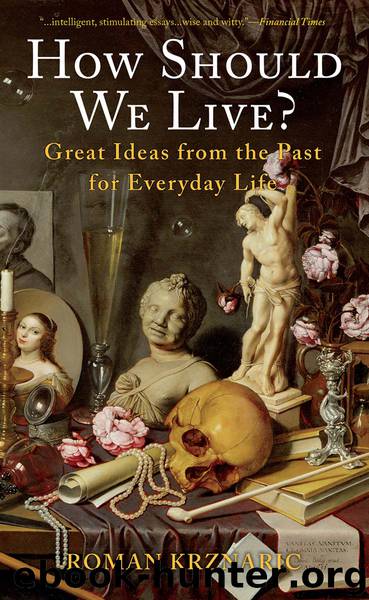How Should We Live? by Roman Krznaric

Author:Roman Krznaric
Language: eng
Format: epub
Publisher: BlueBridge
Published: 2011-06-24T04:00:00+00:00
Thomas Gainsborough, Mr and Mrs Andrews (1750). The couple’s property in rural Suffolk extends as far as the eye can see, a vision not just of naturalistic beauty but of material prosperity.
The legacies of the past are not always easy to detect in daily life. Have we really become as addicted to vision as the history of the senses seems to suggest? Anybody who avidly listens to the radio on their morning commute or who cannot resist the smell of bacon or is taking a course in aromatherapy would probably say their ears and noses are in perfectly good shape, and that they have not succumbed to the tyranny of the eye. Yet have a look at the typical suburban garden.
Gardening is one of the most popular pastimes in many Western countries; Britain alone has millions of devotees. While some people treat their gardens as mini-wildlife sanctuaries or vegetable plots, the majority approach gardening as an exercise in visual aesthetics. What matters more than anything else is how the garden appears to the eye. Does the mixed border have a pleasing combination of colours, heights and shapes? Are there enough plants with ‘winter interest’, which remain attractive throughout the year? Is the lawn a neat and pristine carpet? Is there space for cheerful window boxes full of bright and vibrant annuals, or for an area of colourful bedding plants? How about a double-flowered camellia in the front bed, and a striking deep purple clematis, ‘Polish Spirit’, climbing up behind? When I worked as a gardener, it became obvious to me that the primary objective of contemporary garden design is to create a visually pleasing picture.
Most gardeners do not realise, however, that before 1700 visual beauty in gardening was not nearly as important as it is today. Take, for instance, the history of rose cultivation. Until modern times, roses were mainly grown for their scent, not their appearance. In his Natural History, written in the first century CE, Pliny the Elder provides a detailed discussion of which climates produce roses with the finest perfumes, and how to pick a rose to preserve its scent. Roses were featured in medieval and Renaissance gardens especially for their fragrance, explaining why Shakespeare declared, ‘a rose by any other name would smell as sweet’ – rather than ‘would look as lovely’. In one of the most popular gardening books of the seventeenth century, top prize goes to the damask rose for possessing the ‘most excellent sweet pleasant scent’. But parallel to the general demise of odour in the West, fragrance faded as a desired attribute of the rose from around the eighteenth century. New cultivars were increasingly bred for their size and colour, with little attention given to scent. In the 1890s a historian of gardening was moved to write, ‘a rosery of today would astonish the possessors of gardens in the Middle Ages, and the varied forms and colours would bewilder them, yet in some of our finest-looking roses they would miss, what to
Download
This site does not store any files on its server. We only index and link to content provided by other sites. Please contact the content providers to delete copyright contents if any and email us, we'll remove relevant links or contents immediately.
The Compound Effect by Darren Hardy(8742)
Wonder by R.J. Palacio(8389)
Atomic Habits: Tiny Changes, Remarkable Results by James Clear(8130)
Becoming Supernatural by Dr. Joe Dispenza(8046)
Wonder by R. J. Palacio(7880)
Change Your Questions, Change Your Life by Marilee Adams(7574)
The Road Less Traveled by M. Scott Peck(7480)
Born to Run: by Christopher McDougall(7033)
Daring Greatly by Brene Brown(6374)
Big Magic: Creative Living Beyond Fear by Elizabeth Gilbert(5562)
Grit by Angela Duckworth(5455)
The Slight Edge by Jeff Olson(5322)
Men In Love by Nancy Friday(5121)
The Wisdom of Sundays by Oprah Winfrey(5054)
You Are a Badass at Making Money by Jen Sincero(4738)
Fear by Osho(4625)
The Four Tendencies by Gretchen Rubin(4520)
The Miracle Morning by Hal Elrod(4505)
Rising Strong by Brene Brown(4348)
